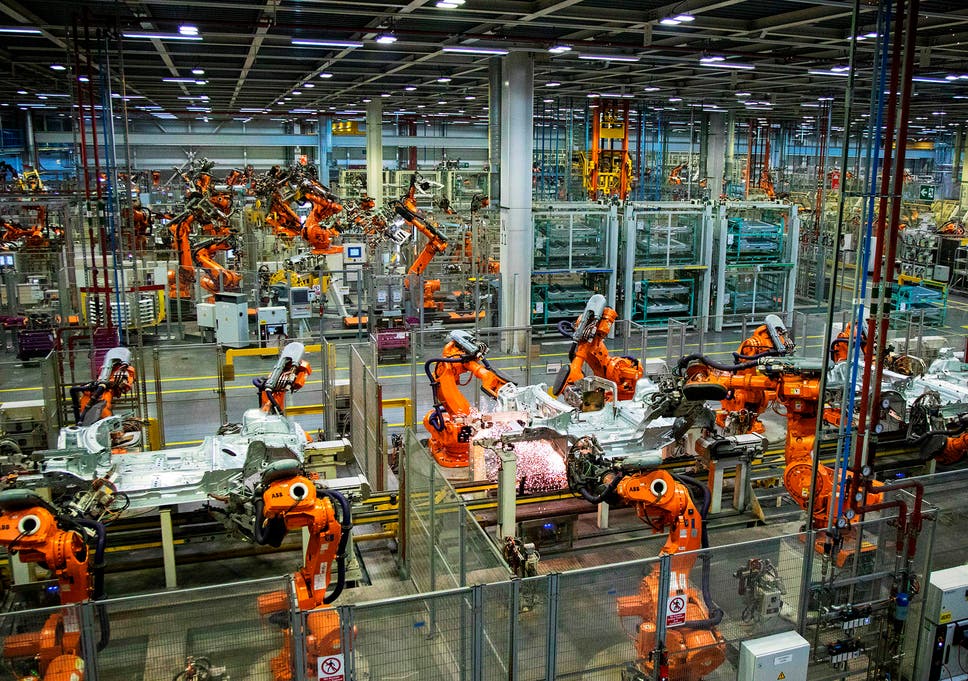'There is a growing body of evidence that automation is disproportionately impacting women, with the overwhelming majority of high paid, high-tech jobs taken up by men,' says researcher
Maya Oppenheim Women's Corresponden

Researchers at King’s College London and London School of Economics discovered introducing robots into the workplace has had a 'sizeable' detrimental effect on the gender pay gap in Europe ( AFP/Getty )
Robots are increasing the gender pay gap because women are more vulnerable to the adverse effects of automation, a study has found.
Researchers at King’s College London and the London School of Economics say the use of robots in the workplace has had a “sizeable” detrimental impact on the gender pay gap in Europe.
The study found that for every 10 per cent increase in the number of robots being used by a company, there was a 1.8 per cent increase in the conditional pay gap between male and female workers.

But researchers did find both men and women saw their pay increase overall due to automation. The Office for National Statistics (ONS) defines automation as tasks currently performed by workers being replaced with technology – potentially involving computer programmes, algorithms, or robots.
Dr Cevat Giray Aksoy, one of the report’s authors, said: “At a time when policymakers are putting increased efforts into tackling gender gaps in the labour market, our evidence is important.
“Our results suggest that governments not only need to ensure that education and vocational training systems provide people with the right skills demanded in the future, but also need to pay attention to distributional issues. They need to increase efforts to make sure that women and men are equally equipped with the skills most relevant for future employability.”
The study, titled Robots and the Gender Pay Gap in Europe, discovered the impact on the pay gap was especially pronounced in what researchers referred to as “outsourcing destination countries”, where gender inequality was already more noticeable at work
“Outsourcing origin countries” – predominantly Western European countries – did not witness a striking rise in the pay gap comparative to automation.
Men were found to be more likely to be in job positions which were higher-skilled and higher in the work-related pecking order which, when coupled with advances in automation, compounded the pre-existing pay gap.
The study analysed data on workplace automation between 2006 to 2014 from 20 European countries and 28 million observations
Researchers looked at patterns in the UK, Spain, Belgium, Bulgaria, the Czech Republic, Estonia, Finland, France, Germany, Greece, Hungary, Italy, Latvia, Lithuania, the Netherlands, Poland, Portugal, Romania, Slovakia, and Sweden.
Fabian Wallace-Stephens, of the Royal Society for the Encouragement of Arts, Manufactures and Commerce (RSA), raised concerns about the study’s findings.
Mr Wallace-Stephens, who is senior researcher at the RSA Future Work Centre, said: “Far from creating a level playing field for the workforce, there is a growing body of evidence that automation is disproportionately impacting women, with the overwhelming majority of high paid, high-tech jobs taken up by men.
“While we are still waiting to see how the pandemic will impact the economy in the long-term, it is likely that this process will accelerate in the coming months. Improving the infrastructure around retraining and re-skilling, alongside a wider culture change, will be necessary if automation is to benefit everyone in our post-pandemic economy.”
A previous report, carried out by the RSA and the Women’s Budget Group, drew attention to the dangers of new technologies worsening existing gender divides in the workplace – calling for recent cases of women suffering from in-built bias in artificial intelligence systems to be met with a “robust response” from policymakers and employers.
The study, which came out last August, warned “algorithmic prejudice” could become one of the new giants of modern poverty if it is left unchecked.
In March last year, the national statistics office announced women in the UK are considerably more likely than men to be working in jobs endangered by the advance of technology.
The ONS said 1.5 million people in England are at high risk of losing their jobs to automation – with women holding more than 70 per cent of those roles believed to be at high risk.
The three occupations with the highest probability of automation were found to be waiters and waitresses, shelf-stackers and basic retail roles – all of which are low-skilled or routine. However, well-educated women were also found to be more at risk than men.
“While we are still waiting to see how the pandemic will impact the economy in the long-term, it is likely that this process will accelerate in the coming months. Improving the infrastructure around retraining and re-skilling, alongside a wider culture change, will be necessary if automation is to benefit everyone in our post-pandemic economy.”
A previous report, carried out by the RSA and the Women’s Budget Group, drew attention to the dangers of new technologies worsening existing gender divides in the workplace – calling for recent cases of women suffering from in-built bias in artificial intelligence systems to be met with a “robust response” from policymakers and employers.
The study, which came out last August, warned “algorithmic prejudice” could become one of the new giants of modern poverty if it is left unchecked.
In March last year, the national statistics office announced women in the UK are considerably more likely than men to be working in jobs endangered by the advance of technology.
The ONS said 1.5 million people in England are at high risk of losing their jobs to automation – with women holding more than 70 per cent of those roles believed to be at high risk.
The three occupations with the highest probability of automation were found to be waiters and waitresses, shelf-stackers and basic retail roles – all of which are low-skilled or routine. However, well-educated women were also found to be more at risk than men.

No comments:
Post a Comment